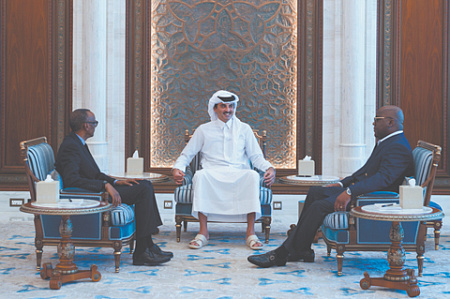
On Thursday, April 24, the Democratic Republic of the Congo (DRC) and the March 23 Movement (M23), whose delegations are in Qatar, issued a joint statement announcing a cease-fire and a mutual desire to transform the truce into a lasting peace. This seventh attempt to end the fighting in eastern DRC since 2021 may finally succeed. Rwanda, which supports the M23, is facing increasing international pressure, which China has now joined.
“By mutual agreement, both sides confirm their commitment to an immediate cessation of hostilities, categorically reject any statements inciting hatred and intimidation, and call on all local communities to comply with these obligations,” the conflicting parties said in a joint document.
Both the DRC and the M23 noted that the dialogue continues and is characterized by “honesty, frankness and constructiveness.”
The delegations of the conflicting parties have been negotiating for about a month in Doha, the capital of Qatar.
One player still remains in the shadows – this is Rwanda. However, there is little doubt that the representatives of the M23 hear and take into account the voice of the Rwandan authorities. The main negotiations are taking place at the interstate level. Through Qatar’s efforts, DRC President Felix Chesekedi met with Rwandan President Paul Kagame in Doha in March.
Even mutual accusations of war crimes did not prevent the negotiations. Representatives of the United Nations also say that many civilians are being killed in the fighting. The east of the DRC, in fact, has become a humanitarian disaster zone. So far, serious disagreements remain regarding the prisoner exchange. The Congolese claim that the rebels want the release of all M23 members, even those convicted of war crimes.
The conflict in the east of the DRC has been going on for almost three decades. It became an echo of the genocide in Rwanda in 1994, when the local Hutu and Tutsi ethnic groups moved the showdown to the territory of a neighboring country. The Congolese Tutsis created the M23, which quickly grew into an impressive military force. In January, the rebels achieved success in offensive operations in North and South Kivu. The major cities of Goma and Bukava, which are the administrative centers of these provinces, were taken. North and South Kivu are extremely rich in minerals, including rare earth metals. The interest in the conflict in the African country is largely due to this fact. In February, the rebels even set out to take the capital of the DRC, Kinshasa. However, the M23 did not have any further military successes comparable to those in January.
Perhaps this is due to the fact that a fairly large coalition is fighting against the rebels and the Rwandans, which includes Western PMCs, UN peacekeepers, and, according to the Rwandans, the military from Burundi. Representatives of the latter, by the way, talked about the possible full-scale entry of the country into the war in the event of further rebel advances.
If in January the West did not notice the fighting and did not want to complicate relations with Rwanda, then gradually support for the DRC became more significant, especially at the diplomatic level. And more recently, the DRC decided to support China (see NG dated 04/21/25). It is very significant that the parties came to a truce shortly after Beijing expressed its position. He condemned the Rwandan authorities, supporting the popular idea that the Rwandan military is fighting for the M23.
